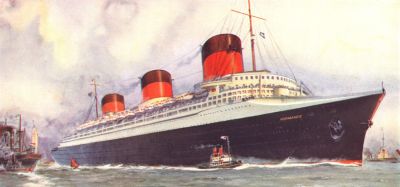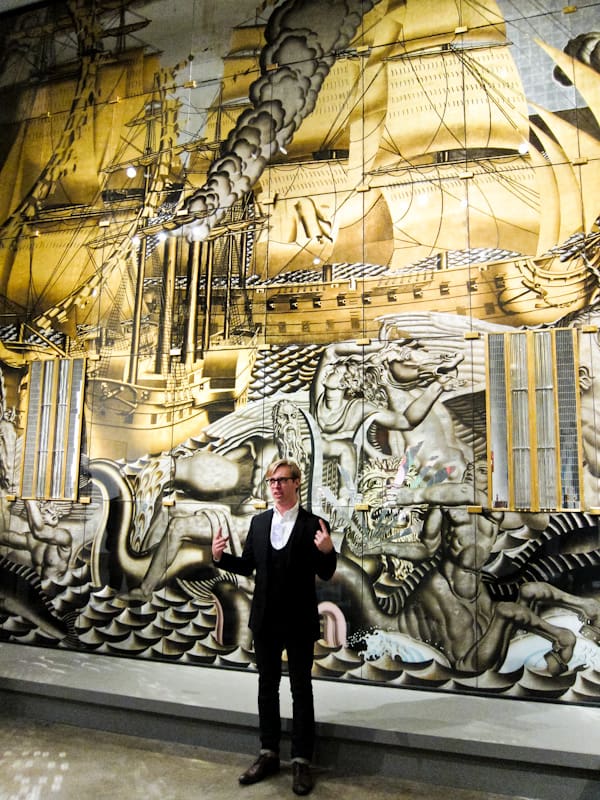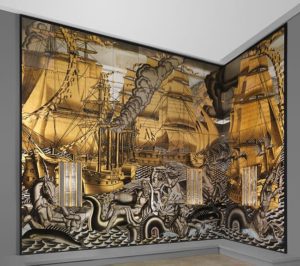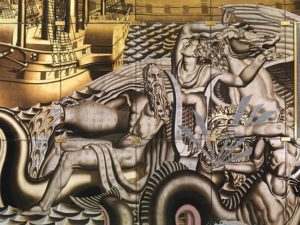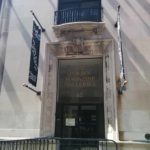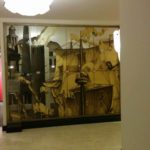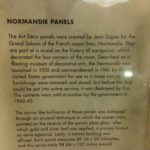I’m fascinated by these beautiful art deco panels created by Jean Dupas for a French luxury liner that the United States seized during World War II.
This website will be a collection of notes and resources during my research of the Normandie Panels.
- Brief History
- Current Owners
- The Forbes Galleries
- Video: My Brooklyn Museum Visit
- Enservio Restoration Blog Post
- Stephen Ongpin Fine Art
- Sotheby’s Catalogue Entry N0 8564
UPDATED: My Latest Normandie Panel Discoveries
Brief History of the Normandie Panels
1932 – The Compagnie Générale Transatlantique begins construction on the Normandie. It is to become the most beautiful and extravagant ship in existence, the epitome of French luxury. The cost of building such a vessel is enormous and unprecedented at the time.
1934 – Jean Dupas designs four murals executed by Charles Champigneulle. Their destiny is to grace Normandie in her first-class lounge. Their beauty is achieved through the verre églomisé technique of gilding the backside of glass with metal leaf. In this case, the Normandie panels are gilded with gold, silver, and palladium leaf. The front of the glass is painted in black with mythological scenes and massive ships.
1935 – The expense of the ship and labor of the artwork is proven well worth it. The Normandie launches from France for the first time. The ship is everything the passengers had hoped for and more. Gourmet food, wine, and a lovely atmosphere make for a one-of-a-kind experience.
1939 – In August, the Normandie docks into New York. France had recently fallen under Nazi control, which makes the return journey impossible for the Normandie.
United States Seizure
1941 – The United States seizes the Normandie for use as a troop carrier on December 24.
1942 – On February 9, decorations and non-necessities start to be removed when life preservers are accidentally lit on fire. The ship burns through the night. Water is sprayed in the ship to tame the fire. The water freezes overnight, and capsizes the great ship.
1943 – After sitting stagnant at Pier 88 for 18 months, the Normandie is removed and sold for scraps.
1976 – “The Chariot of Poseidon”, a portion of the grand glass mural, is acquired by the Metropolitan Museum of Art.
1981 – Malcolm Forbes bids on some panels from the Normandie. On March 21, he pays a total of $99,000. These panels can be seen today at the Forbes Gallery. LOCATION UNKNOWN AS OF NOV 2015
Since the 1980’s, several other portions of the mural have been sold off to both museums and individuals. These panels always go for a hefty amount to those who appreciate the preciousness of the artwork and the fragility of their dramatic history.
Photographs
Here’s a picture of me standing in front of the most complete collection of the panels:
Giving a tour to my friends of the Metropolitan Museum of Art for my birthday.
Current Owners of Normandie Panels
- The Metropolitan Museum of Art in New York, NY USA (also see this complete record)
The Forbes Galleries on 5th Avenue in New York, NY USA LOCATION UNKNOWN since the gallery closed!! Have tried calling everywhere and nobody knows what happened to these.SOLD AT AUCTION- The Brooklyn Museum in Brooklyn, NY USA
- Private Collector in Houston, Texas
- many more — the panels were split up and sold at auction around 1943
Documented History
- NEW APRIL 2019: Fascinating images of SS Normandie
- Wikipedia page about the SS Normandie
- Blog post includes great summary + Met pictures
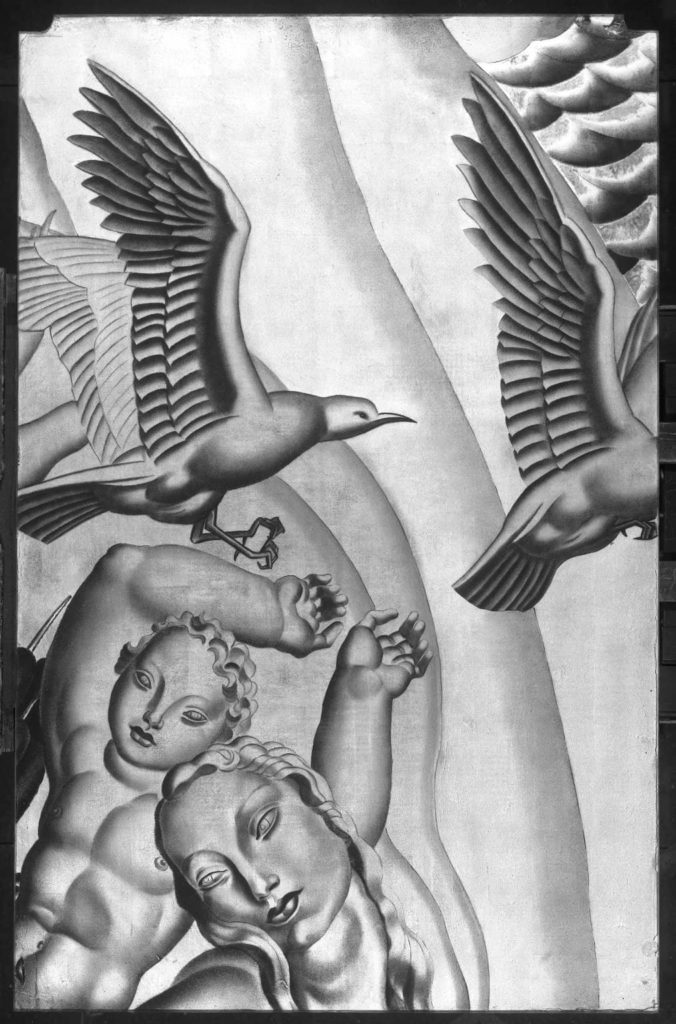
The Forbes Galleries CLOSED CLOSED
The Forbes Galleries featuring several panels were located on 5th Avenue near my apartment, between 12th and 13th Street. Here’s a photo of the entrance and pictures of the panels inside:
Description of Normandie panels from the wall plaque
The Art Deco panels were created by Jean Dupas for Grand Saloon of the French ocean liner, Normandie. They are part of a mural on the history of navigation, which decorated the four corners of the room. Described as a floating museum of decorative arts, the Normandie was launched in 1935 and commandeered in 1941 by the United States government for use as a troop carrier. The furnishings were removed and stored, but before the ship could put into active service, it was destroyed by the fire. The contents were sold at auction by the government in 1942-43.
The mirror like brilliance of these panels was achieved through an unusual technique in which the scenes were painted on the reverse of the panels plate glass, after which gold and silver leaf was applied, a process known as verre eglomise. Lastly, a canvas backing was affixed. Each panel measures 49 1/4 x 30 1/4 inches, and this series totals 98 3/4 x 122 inches overall.
Brooklyn Museum Video: My Visit to the Normandie Panel
Enservio Restoration Blog Post
I’m replicating it here because I noticed that the images were broken on the site, and I’m worried they might delete the article one day.
The Value of Historical Significance
Posted on July 10, 2013 by Erin Hollenbank
Only on rare occasions does the historical significance of an item outweigh the value of the item itself. Recently Enservio Select received a request to appraise a glass panel from the infamous S.S. Normandie, a French luxury liner ship which capsized during WWII. The piece was an Art Deco verre églomisé (glass gilded) reverse painted panel from the 1930s, painted by Jean Dupas (French, 1882-1964), and was created as part of a larger glass mural for the SS Normandie’s Grand Salon. The panel was unfortunately broken during transport and we, not only, had the task of putting a monetary value to the piece, but a salvage value as well.
More valuable than the panel alone was the history and provenance which accompanied it. In the 1930s, French Art Deco artist Jean Dupas was asked by the French Line Compagnie Générale Transatlantique for a composition extolling the delights of Normandy for SS Normandie, an ocean liner built in Saint-Nazaire, France. Rather than painting canvas, Dupas chose to apply paint to the reverse of glass in a series of four thematic murals for the Grand Salon in the SS Normandie: “The Birth of Aphrodite,” “The Chariot of Poseidon,” “The Chariot of Thetis,” and the “Rape of Europa.” Dupas was assisted by églomisé specialist Charles Champigneulle who enriched the artist’s outlines with layers of black, gold and platinum washes. The four glass murals were displayed in the ship’s Grand Salon, which comfortably seated 700 people, was furnished with Jean Rothschild and Jean Dunand Furniture, and adorned Lalique fixtures. The Normandie became known as a floating palace of an ocean liner ensconced from stem-to-stern with top-notch Art Deco décor.
Each of the four murals was essentially a mosaic, assembled from dozens of glass panels, anchored by bronze brackets at the corners. During World War II in 1942, when the Nazis invaded France, the Normandie was seized by US authorities in the New York Harbor and renamed USS Lafayette to be retro-fitted for war. Many of the art items, including the Dupas glass mural panels, we taken off before the retrofitting, and sold at a series of auctions. The largest collection of Dupas panels extant was donated to New York’s Metropolitan Museum of Art, preserving for posterity an entire corner of Normandie’s Grand Salon. During the conversion for wartime use, the ship caught fire and capsized in the Hudson River. Fortunately, most of the furnishings and décor had been removed prior to the fire and have been sold throughout the years at auctions.
The glass panel we were asked to appraise is an example of one of the panels which made up the large murals in the SS Normandie. It is a 32” x 48” piece of the “Chariot of Thetis” mural. Though it is only a fragment of a larger mural, it still holds significant value. Groups of Jean Dupas panels from the SS Normamdie have sold at Christie’s and Sotheby’s for $105,000.00- $192,000.00 since before 2005; however, they have seen a significant increase of value as of late, when Sotheby’s sold 10 panels for $512,500.00 and Christie’s sold a similar group for $578,500.00. The most comparable and recent sale was Sotheby’s March of 2013 sale of a single panel from Dupas’ “Birth of Aphrodite” mural. The singular panel sold for approximately $90,000.00, almost the same amount that groups of six Dupas murals were selling for in previous years. The upsurge in value is an indication of the heightened public interest and rarity of the panel; as they are being sold into personal collections, the availability in the market is scarce. Through much research and investigation, Enservio provided an appraised value of $90,000.00 for the subject panel.
The condition of the subject glass panel, at claim intake, was very poor. It had been shattered and was considered a total loss by the owner/policy holder and the insurance company. The policy holder received the full replacement value for the panel, though we felt we could help the insurance company obtain a salvage value for the piece. We selected a specific conservator whose general expertise is Tiffany glass, and who has worked on a shattered Normandie panel in the past, to inspect and conserve the work. While it will be months until we see the end product, we are still confident that the piece will have a significant salvage value post-restoration and that the insurance company can retrieve a large portion of the loss payout.
In this rare instance, a seemingly total loss item was saved by its history. In most cases, broken glass is considered a total loss, as glass is not a forgiving medium in the aftermarket for resale. However, in this case, the provenance and historical significance of the object, as well as the rarity, was important enough to consider options.
Stephen Ongpin Fine Art
He is private dealer, agent and consultant in the field of Old Master and Modern drawings based in London. His company’s website lists for sale this beautiful study for The Chariot of Poseidon Mural for the S.S. Normandie:
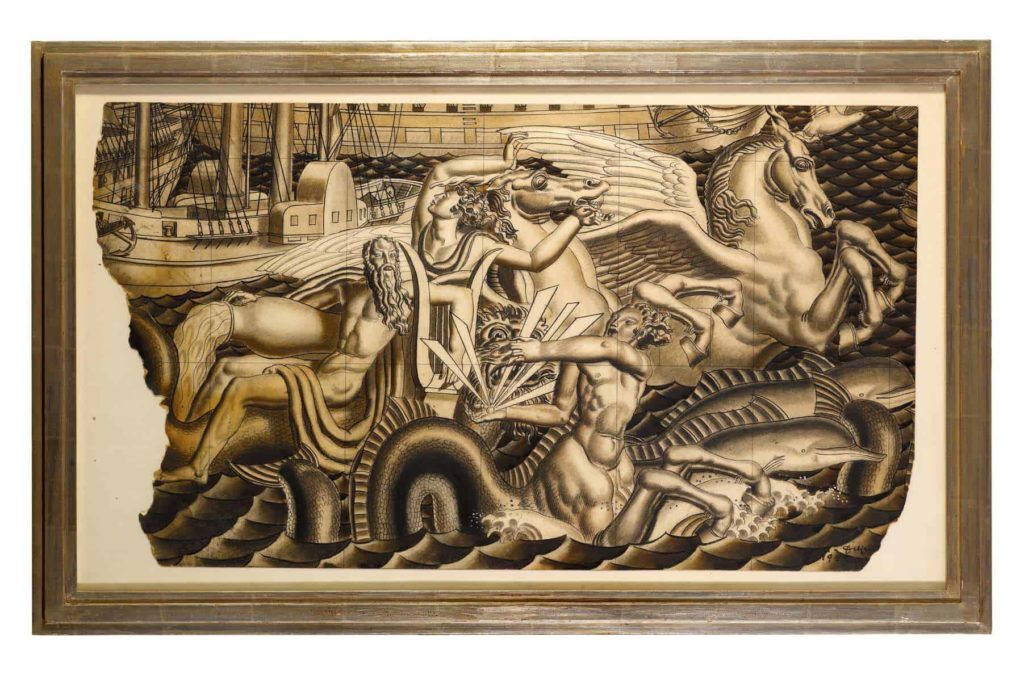
Jean Dupas reached the height of his fame in the mid 1930’s, and in 1934 he received his most important commission to date; a series of large glass murals to decorate the Grand Salon of the new French ocean liner, the Normandie. This large drawing is a preparatory compositional study for The Chariot of Poseidon, part of Dupas’s most famous work; the four hundred square metres of glass mural decoration installed in the Grand Salon of the S.S. Normandie. The most beautiful and luxurious ocean liner of its day, the Normandie was launched in 1932 and made its maiden transatlantic voyage in May 1935. Intended as an exemplar of French engineering and design, the ship’s lavish interiors served as showcase of French Art Deco, incorporating specially commissioned work by such leading designers and craftsmen as Jean Dunand, Emile-Jacques Ruhlmann, René Lalique and Jean-Michel Franck, as well as Dupas.
Completed in 1935, the panels for the Grand Salon were in executed on giant glass panels in the technique of verre églomisé, and were the result of a collaboration between Dupas and the glassmaker Jacques-Charles Champigneulle (1882-1964). The four paintings depicted The Chariot of Poseidon, The Sea Nymph Thetis, The Birth of Venus and The Rape of Europa.
Dupas’s Normandie panels have long been recognized as his finest work. As one scholar has written, ‘“The larger my work, the happier I am’, writes Dupas who, with this ensemble, realizes his most accomplished masterpiece. The brilliance of glass, sumptuously enhanced with panels of gold, silver and palladium, exalts the supreme rhythm that runs through these panels, a composition both tumultuous and majestically organized against a backdrop of tangled sails and large vessels. Sea horses, tritons and dolphins, under the control of sculpted deities, prance on a sea of shells; there reigns a sort of Golden Age jubilation which is like the dream, at last fully made real, of Dupas.’
The present large sheet shows traces of the damage it received in a fire in Jean Dupas’s studio that destroyed much of his work. A glimpse of the artist’s crowded studio was provided by the Art Deco illustrator George Barbier in his article on Dupas, published in 1927: ‘The activity of our artist is amazing; in his atelier, frames accumulate constantly against the walls; canvases cover canvases; the tables are heaped with sketches; loose leaves are pinned to the walls – sketches of some graceful movement, of some Virgilian landscape. One is forced to climb over the cartons on which Dupas traces his life-sized figures, or the large scrolls representing the columns for some temple yet unbuilt. Enough cannot be said in praise of these charming studies, where the black pencil, here and there relieved by a touch of red chalk, takes on a caressing sweetness, a voluptuous grey.’
The first owner of this drawing was the painter Marguerite Grain (1899-1986), a pupil of Dupas who also posed for a number of paintings by the artist.
Provenance: Marguerite Grain, Paris. Her estate sale, Paris, Hôtel Drouot, 26 February 1987, lot 5 bis. Steven A. Greenberg, New York, until 2012.
—————
One of the leading artists of the Art Deco period, Jean Dupas was commissioned in 1934 to provide 400 square metres of murals to decorate the Grand Salon of the new French ocean liner, the Normandie. The panels were devoted to the theme of The History of Navigation, with the artist working in a technique of verre églomisé, on giant glass panels. The huge panels were removed from the ship shortly before its transformation into a troop ship during World War II, in the process of which the ship was destroyed by fire in February 1942.
Damaged in a fire in the artist’s studio, this large sheet is a rare preparatory study for one of Dupas’s murals for the Normandie. The corresponding mural of the Chariot of Poseidon is now in the Metropolitan Museum of Art in New York.
Sotheby’s Catalogue Entry N0 8564
As listed in the Important 20th Century Design auction held in New York on June 12, 2009. Item N08564 is described as:
LOT 59, PROPERTY FROM AN IMPORTANT MARITIME COLLECTION
ca. 1934, executed by Jacques Charles Champignuelle
ESTIMATION 30,000-50,000 USD
Lot vendu: 46,875 USD
This panel is part of the monumental “Rape of Europa” mural which formed part of the elaborate interior design of the Grand Lounge aboard the French luxury liner the S. S. Normandie. Jean Dupas conceived this mural as part of a series of four themes that wrapped the interior walls of the cross-shaped lounge. The three other murals represented “The Birth of Aphrodite,” “The Chariot of Poseidon,” and “The Chariot of Thetis.” The four murals offered a continuous glittering scene that blended Classical mythology with a secondary theme of maritime history. The present panel is exceedingly rare in that it portrays the the sole image of a sun from the group of four murals executed for the Grand Lounge.
Conclusion
The end… for now. Updates forthcoming.
If you have any news about these Normandie panels or want to sell your collection, please email me at [email protected].
Update, January 2016: Someone emailed me, and he has 1 panel in his garage!
Update, March 2016: Many panels in Houston, Texas private collection
Update, June 2020: I haven’t received many updates recently. But you can see all of my Normandie panel articles here, including news on the Forbes auction.

